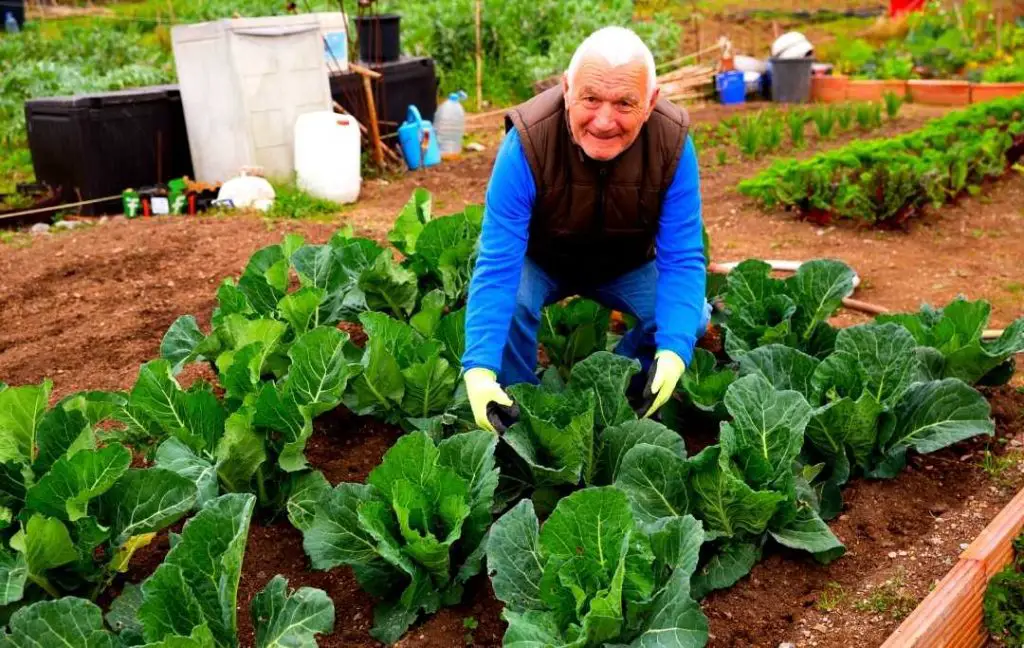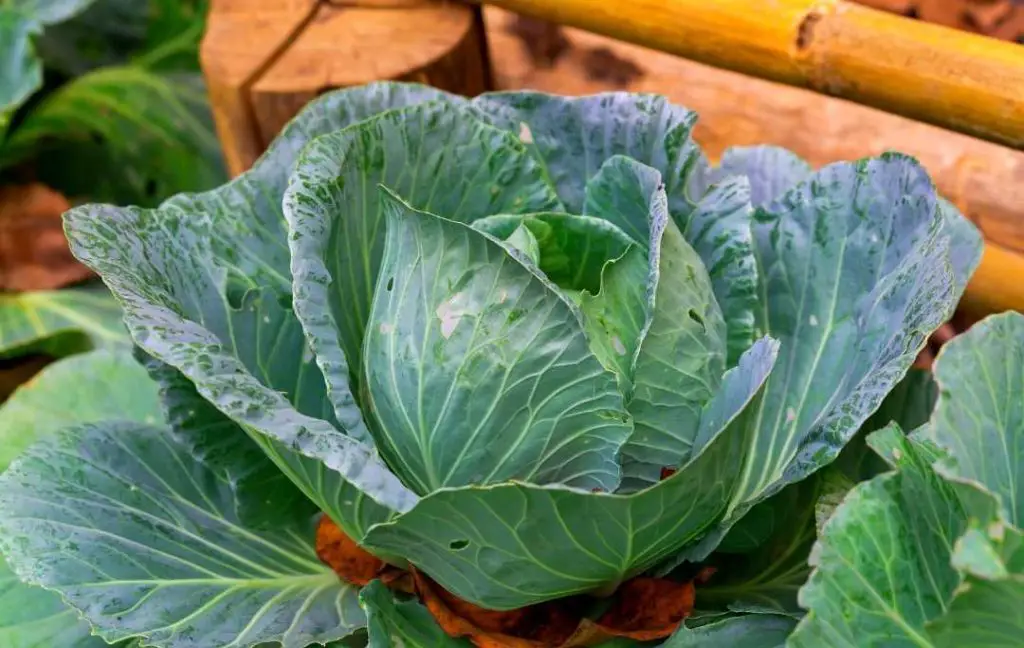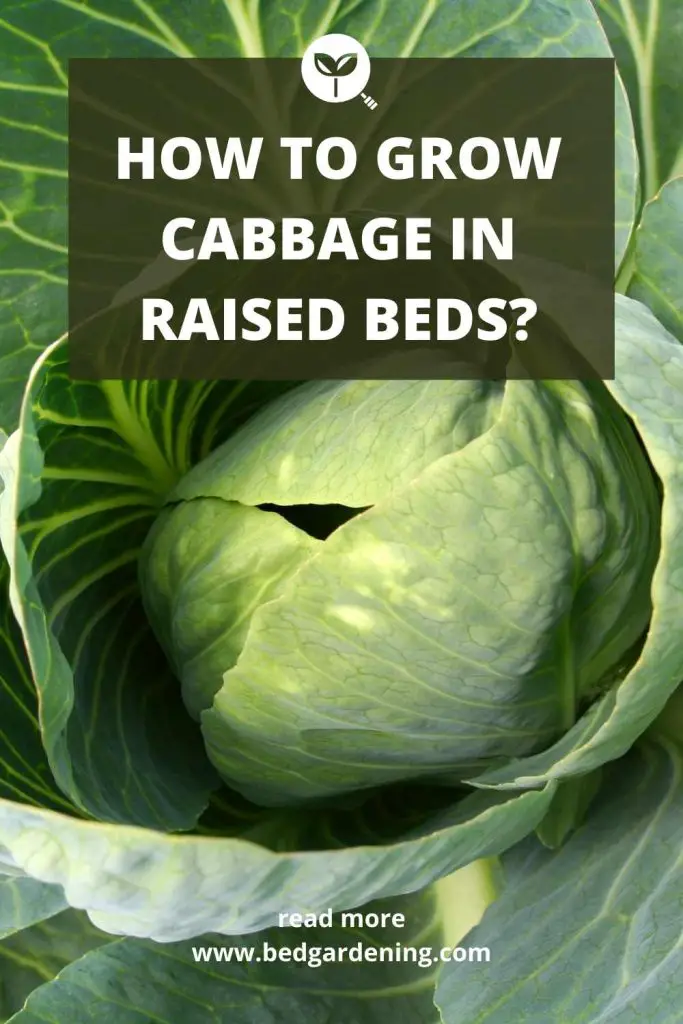Cabbage likes to grow in cold climates. As this vegetable is not too fussy that’s why you can easily grow it in your garden. In this article, we are going to discuss with you how to grow cabbage in raised beds.

If you are facing the problem of limited space in your garden and you want to grow many vegetables then growing in raised beds is a good choice.
You can build your own raised bed or buy it from any gardening store or you can also order it online. There is no need for special skills for building a raised bed. By following simple DIY steps you can build.
Why Grow Cabbage In A Raised Bed?
If you grow vegetables in a raised bed then you can maintain the fertility of the soil. You can fill the raised bed with high-quality soil which is not possible when you grow plants in the ground.
If you are facing any physical issue then a raised bed is a good solution. Most people are interested in gardening but due to their backache. They can’t look after their plants as kneeling and bending is part of the gardening. But when you grow plants in a raised bed then you can easily take care of your plants.
You can also use portable raised beds if you are living in a rented house. When you move you can take your raised bed.
The Size Of Raised Bed
The size of the raised bed is very important. You should not buy or build a wider raised bed because you can’t reach the plants which you grow at the center.
In a wider raised bed, middle plants always neglected to avoid such problems. You should build or buy a raised bed of size 4 × 4. This is the best size of the square raised bed. If you want to grow plants in a rectangular raised bed then the perfect size is 3 to 4 ft wide and 6 to 8 feet long.
The location of the raised bed is very important. You should consider it very seriously. Select that area that gets at least 6 to 8 hours of sunlight daily.
When To Plant Cabbage?
This is a cold-weather vegetable and it likes cool temperatures. It can’t tolerate too much heat or severe frost. In that situation, it will not form heads.
You can plant the seeds between March and June for spring crops or between September and October for fall crops. It depends upon your climate.
If you are living in a cold climate then cabbage can be your spring or fall crop. You can ask any local nursery about the frost date.
- You can sow the seeds 8 weeks before the last spring frost. OR
- You can sow the seeds 14 weeks before the first fall frost.
In four mild winter areas, this crop will grow best during the winter. In such areas, you can sow the seeds from the end of August through December.
The best temperature for growing cabbage is between 45 to 75 degrees Fahrenheit or 7 to 24 degrees centigrade.
Cabbage Sowing And Planting Tips
- You can start cabbage plants from seeds or transplants.
- The seeds of cabbage are viable for 4 years.
- It is better to start the seeds 4 to 6 weeks before the last frost or 10 to 12 weeks before the first frost. You can choose the spring or autumn season for sowing the seeds.
- Make sure to sow the seeds in individual pots. Use seed starting mix for filling the pot.
- The hole you make for sowing the seeds should be 1 by 4 to 1 by 2 inches deep. After sowing the seeds, cover them with a light layer of starting mix. Keep the soil mix moist.
- Within 5 to 8 days, you will see the seeds will start germinating. The suitable temperature for the germination of seeds is 77 degrees Fahrenheit or 25 degrees centigrade.
- When your seedlings grow 4 to 6 inches then this is the right time to transplant them in your raised bed.
Cabbage Planting And Spacing
- If you are planning to grow cabbage from seeds, sow the seeds ½ inch deep in the soil of your raised bed. Leave a space 12 to 18 inches. It is suggested that you should plant 1 cabbage per square but it depends upon the variety which you are growing. If you leave a small space between two heads then the size of the heads will be smaller.
- If you are transplanting cabbage then seedlings should be 4 to 6 weeks old. All the seedlings have 4 to 5 true leaves. Make sure leggy or stemmed plants should be planted deeply. Bury the main stem 1 to 2 inches deep below the top two sets of leaves.
- If you are sowing the seeds in early spring then you can cover the soil of the raised bed with a black plastic or garden fabric. This will help to warm the soil and keep the soil moist.
- If you want to get a continuous harvest then it is suggested that you should plant succession crops. It means you should sow the seeds every two weeks or plant early and midseason varieties at the same time. In this way, you will get a mature crop at different times.
How To Care For Your Cabbage Plants?

Cabbage likes to grow in rich and fertile soil. It likes full sun but also grows well in partial shade.
SOIL
The soil which you are using for filling your raised bed should be rich in nutrients. It is suggested that you should use well amended and well-drained soil. Make sure your soil has all the essential organic matter. You can use manure or compost to make your soil rich in organic matter.
WATERING
The frequency of water should be even for your cabbage plant. If your plants get uneven water that will result in stunted or cracked heads. Your cabbage plants need 1 to 1 ½ inches of water every week. Avoid overwatering because it will result in splitting the heads of cabbage.
FEEDING
When midseason comes you should fertilize your cabbage plants. The fertilizer which has high nitrogen like 10-5-5 is best. You can also apply a dilute solution of fish emulsion or seaweed every two weeks. Cabbage is a heavy feeder so don’t let it hungry and fulfill its requirement for nutrients.
PESTS AND DISEASES
Cabbage worms, cutworms, slugs, and snails are easily attracted to cabbage. They can ruin young cabbage leaves. If you see aphids attacking your plant it means your plant is facing water stress or heat stress. You can follow the following tips to prevent your plants from diseases and pests.
- When cabbage plants are young you can cover them to prevent them from pests.
- If you grow radish and onions near cabbage plants then they will help deter pests.
- The young cabbage plants are in danger of cutworms. So you should place a protective collar around them. You can also use newspapers for this purpose.
- Whenever you see caterpillars then a handpick is an easy and simple solution.
- You can get rid of aphids by a heavy flow of water. Insecticidal soap is another option.
- You can protect your plants from soil-borne disease by rotating your cabbage plants. If your cabbage plant becomes the victim of soil-borne disease then you should discard the plant and rotate the crop for next year. You should wait until three years before planting cabbage in the same location.
- You can prevent your plant from diseases by removing the entire plant after harvesting. Avoid leaving the roots in the ground to protect your next year’s crop.
Harvesting
Cold weather improves the flavor of cabbage. Cabbage has the property to tolerate light cold. You should harvest your crop before the temperature rises.
In case, you sow the seeds then the maturity time of cabbage is about 80 to 180 days. If you transplant the seedlings then your crop will be ready in approximately 65 to 105 days. It depends on the variety which you are growing.
- When you see heads are formed and firm then you can harvest them. Use a sharp knife for cutting the cabbage. If you want a second crop then cut the head off high on the plant. Make sure you leave many outer leaves. You can harvest the cabbage head when it reaches the size of a tennis ball.
- If you want to use the method cut-and-come-again then harvest only older outer leaves and leave the center of the plant; it will encourage the growth of new leaves. You can harvest leaf cabbage about a month after planting.
- When harvesting is complete you can remove the roots and stem of the plant. This will prevent your new crop from soil-borne disease.

Store And Use Homegrown Cabbage
If you see loose leaves on your cabbage head then remove them. Wrap the head in a damp paper towel and store it in a plastic vegetable bag. You can store cabbage for three to four weeks in the refrigerator.
